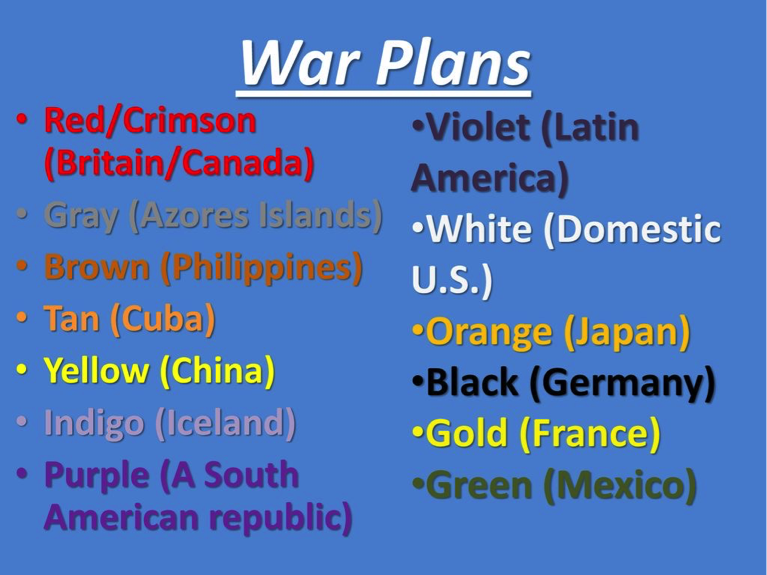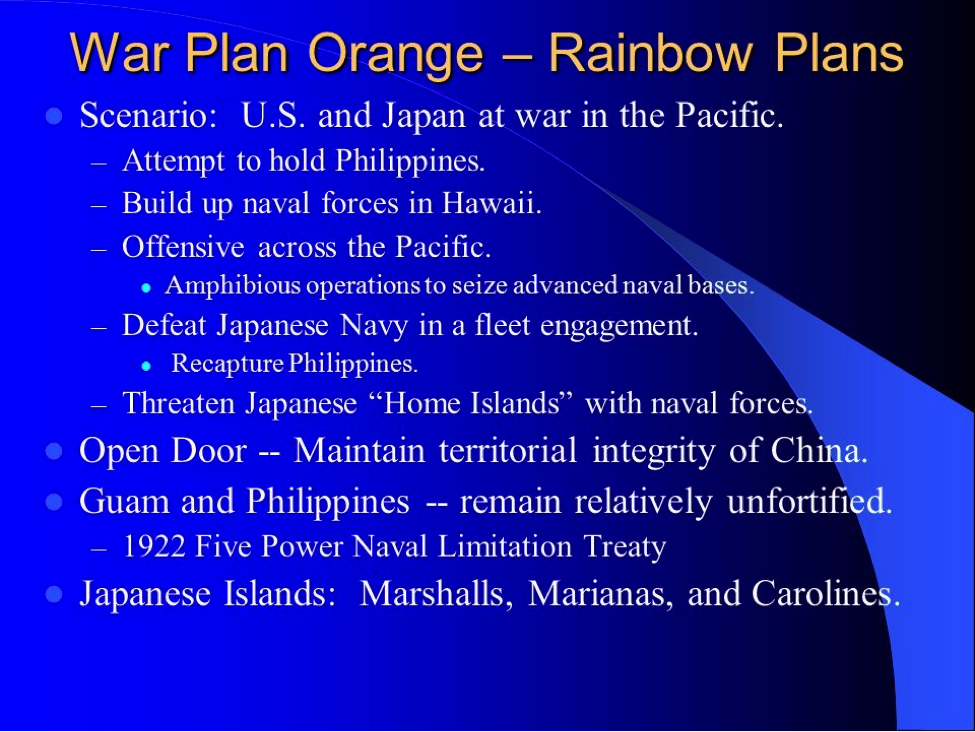 In the world of historical fiction, one subset that has always been popular is the “what if” scenario. Wars are an intriguing starting point for these stories, as it can be fun to go down the rabbit hole of alternate endings. What if Germany won World War II? What if the U.S. ceded the South to the Confederacy? What if the South had won at Gettysburg?
In the world of historical fiction, one subset that has always been popular is the “what if” scenario. Wars are an intriguing starting point for these stories, as it can be fun to go down the rabbit hole of alternate endings. What if Germany won World War II? What if the U.S. ceded the South to the Confederacy? What if the South had won at Gettysburg?
Beyond the big questions, we have a slew of smaller “what if” conflicts, thanks to now-defunct drafts of war plans. During the late 1800s and early 1900s, many of the European powers, as well as America, developed plans in case of an attack by various nations or empires. While we could spend countless hours diving into the different plans drawn up, today we’re going to discuss one in particular: war plan Black.
To help you get some context, this plan was one of many drafted before the Great War of 1914, and many of them were adjusted as the war played out. Black outlined the U.S. strategy for a German invasion, and interestingly, the Germans had made plans of their own. If you’re a fan of historical fiction, you’ll appreciate learning how the two powers envisioned a head-to-head conflict on America’s turf.
A Brief Overview of the U.S. War Plans
As early as 1904, the American War Department had begun to use color-coding, along with abbreviated names and symbols, to reflect different countries. The primary purpose of this system was so that the Army and Navy could develop a unified attack strategy using the same colors and names.
Starting in the early 1920s, the U.S. began to develop war plans, using the colors already in play for the different countries. For example, since Great Britain was red, War Plan Red was a strategy of conflict against Britain and its colonial allies, most notably Canada. In all of these drafts, the U.S. was always referred to as “blue.”
What’s crucial to point out is that the development of these plans is relatively standard for military powers. Usually, the reasoning is that, should a conflict arise, it’s better to have a plan in place, rather than waste time drafting new tactics on the fly. Even if war seemed inconceivable at the time, these plans were created as a “just in case” fallback. Planning is actually what most militaries do best.
One of the more well-known plans was War Plan Orange, which saw the U.S. fighting against the Japanese Empire. Given how the Japanese were expanding aggressively throughout the Pacific Ocean, and that the Imperial Navy was one of the best in the world, American strategists saw war as inevitable. Some components of the plan were even used during World War II, although they were folded into a “Rainbow Plan” to deal with the other Axis powers.
Some other examples of color-coded war plans include:
-War Plan Brown – A strategy for defeating an uprising in the Philippines, where the U.S. had military bases and troops stationed.
-War Plan Gold – A plan for engaging with France and its Caribbean colonies, such as Haiti.
-War Plan Green – U.S./Mexico relations were strained during the 1910s, particularly with the -Mexican Revolution. This war plan envisioned an invasion strategy to install a more pro-American government.
Most of these plans never came to fruition (obviously), and the system of color-coding was scrapped after World War 2. However, War Plan Black, when seen from both sides, offers some valuable insight into what goes into war strategy before a major conflict.
War Plan Black – Fighting Against a WW1-Era Germany
In the modern era, it can be hard to believe that the United States did not have much in the way of a standing army pre-World War 1. Whenever the country would go to battle, the president had to ask Congress to declare war, and the military would mobilize troops and train them from there.
At the time, America’s standing army was roughly 100,000 troops, but many of them were stationed overseas in places like the Philippines and the Panama Canal. The canal was of supreme importance since an attack and invasion there could cut supply lines and prevent naval ships from moving between the Pacific and Atlantic Oceans. Part of War Plan Black anticipated the German assault of Panama because of its strategic location.
So, in the event of an invasion of the mainland U.S., the military realized that they couldn’t mobilize fast enough to prevent the Germans from gaining a foothold. Not only did America lack the troops to defend the most significant ports along the eastern seaboard, but the vast coastline of the country was impossible to monitor, which meant that German craft could easily find a landing zone with no defenses.
The two ports that were most likely to be hit would be New York or Savannah. When the plan was revised in 1916, during the height of the war, the U.S. decided to concentrate naval forces in New England. Since the Germans would be coming across from European shores or the North Sea, it made the most sense to congregate and monitor the waters in the North Atlantic.
What the brass didn’t realize, however, was that the Royal Navy held the Germans back quite well, so the chances of German ships breaking out and coming to America were slim. Even if a few vessels could make the voyage, there wouldn’t be enough supplies to launch a full-scale invasion.
Another element that escaped the U.S. Navy was Germany’s reliance on submarines. They assumed that they would be facing a fleet of battleships, destroyers, and other craft, not underwater vessels.
Protecting the Caribbean
A significant component of War Plan Black was to monitor France’s colonies. The worry was that Germany would break through the French defenses and take the country. If that were to happen, they would have access to French ports and would likely try to seize her colonies in the Caribbean. From there, it would be easy for the Germans to reach Panama and the southern U.S.
To combat this potential problem, the Navy would deploy its own subs to watch the waters around Haiti, as well as the Panama Canal. In addition to patrols, the submarines would also lay underwater mines to repel enemy ships.
On the mainland, the Navy enacted several war games to ready ground troops to repel an attack from the sea. Many of the armaments along the coast hadn’t been used, so most soldiers were unfamiliar with them. At the time, war games weren’t prevalent, and after the war ended, they were largely abandoned until the U.S. was thrust into global conflict yet again.
Operations Plan I Through III – The German Plans for an American Invasion
It’s easy to understand a strategy from your own side, but what did the Germans think of going to war with the United States? Interestingly, a plan was ordered by Kaiser Wilhelm III as early as 1897. Even then, the Germans realized that occupying the U.S. would be a foolish mission. Instead, these plans aimed at diminishing America’s resources and influence. Crippling the U.S. was the goal, and from there, Germany could have the leverage to bargain for a more favorable surrender.
Three proposals were drafted between 1897 and 1906. The plans were adjusted based on geopolitical events at the time, such as the U.S. gaining territory after the Spanish-American War in 1898. Here is a brief overview of each plan.
Operations Plan I
Prepared by naval Lieutenant Eberhard von Mantey, the primary goal of this plan was to attack American naval bases on the east coast. With the U.S. forces diminished, the Germans could move toward Washington D.C., facilitating a quick surrender.
Key points in this plan were the bases at Hampton Roads in Virginia and the Portsmouth Naval Shipyard between Maine and New Hampshire. New York was believed too fortified to attack directly.
Operations Plan II
When the United States emerged from the Spanish-American war in 1898, it gained territories within the Caribbean, including Puerto Rico and Cuba. Because of this, the war plan had to be adjusted to account for new naval bases on these islands.
So, rather than focusing on a naval bombardment of the coast, this revised plan had ground troops landing in Cape Cod and Sandy Hook. These soldiers would be accompanied by heavy artillery and naval warships, with their primary targets being New York and Boston. Since these cities were too well fortified from the sea, a ground invasion was the best option. To help stage these attacks, the Kaiser wanted to set up a base of operations in Cuba. This would require taking the U.S. base by force first.
Operations Plan III
The final invasion strategy refined the landing points on the eastern seaboard, opting for strikes at Cape Ann and Provincetown, MA. The soldiers would form a pincer attack on Boston, and once the city fell, they’d turn their sights on New York.
The other significant addition to this plan was the assault of Puerto Rico. If the Germans could take the island, they’d be within striking distance of the Panama Canal, which would cause the Americans to panic even further.
Overall, each of these plans was too big and too ambitious to be taken seriously. The primary obstacle was Germany’s waning naval superiority. While the British and American navies were ramping up, Germany just couldn’t keep the pace. By 1906, it was clear that the U.S. would be too prepared and too strong to take by surprise, so all plans were shelved indefinitely.
Conclusion
We’ll just have to wait for the novel to see how it would play out. And while the U.S. no longer uses the color-coded war planning system, you can be assured that some kind of very detailed war planning system is in place. I’d love to see it; wouldn’t you?
